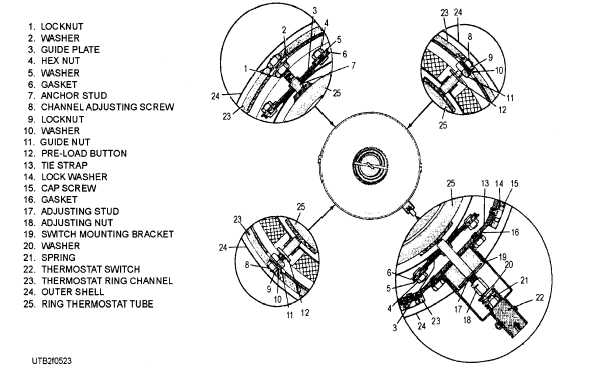Home > Construction Training Manuals > Utilitiesman Basic Volume 02 > Figure 5-23.Ring Thermostat Control

Figure 5-23. - Ring thermostat control.
The automatic damper should be kept in proper adjustment to ensure a proper supply of air to the burner.
The burner manifold (fig. 5-24) requires cleaning and adjusting at times to keep it in good shape. Remove the manifold. Scrape carbon deposits from the manifold and ignition electrodes. Clean the burner nozzles and strainer.
CAUTION
When cleaning, you should NOT use a sharp instrument that can scratch or disfigure the tip orifice or slots in the distributor. A slight scratch on these parts can seriously impair nozzle operation.
Adjust the ignition electrodes to conform with the dimensions shown in figure 5-24. The gap must be positioned as accurately as possible, so it is at the immediate edge of the nozzle spray. Be careful when bending and adjusting the electrodes to avoid cracking the insulators. The insulators may develop an invisible short due to such a fracture, resulting in ignition failure.
The fuel pressure to the burner must be properly maintained. Excessive fuel pressure causes the burner to smoke and results in sooting of the heating coil. However, if fuel pressure is too low, the plant comes up to pressure slowly and does not maintain adequate steam pressure during periods of maximum steam demand. Adjust the pressure as needed.
Figure 5-25 shows a drawing of a fuel pressure switch. To adjust the switch, close the light and fuel indicator pilot when fuel pressure rises to about 70 psi by turning the adjusting screw (1) clockwise to increase or counterclockwise to decrease pressure at which the switch closes. This step allows enough pressure to induce proper atomization when fuel is admitted to the burner. Secure the adjusting screw with the locknut after adjustment.
The steam pressure switch (SPS) can be adjusted to open and stop the burner at any maximum pressure between 65 and 195 psi. The switch closes and restarts the burner when steam pressure drops about 8 psi below that point.
The modulating pressure switch (MPS) is normally adjusted to modulate the burner to "low-fire" operation when steam pressure reaches 10 psi below maximum and to return the burner to "high-fire" operation when steam pressure drops about 8 psi below that point. The recommended setting of 10 psi below the maximum, in most cases, provides both stable operation and stable steam pressure during fluctuating demand.Continue Reading
